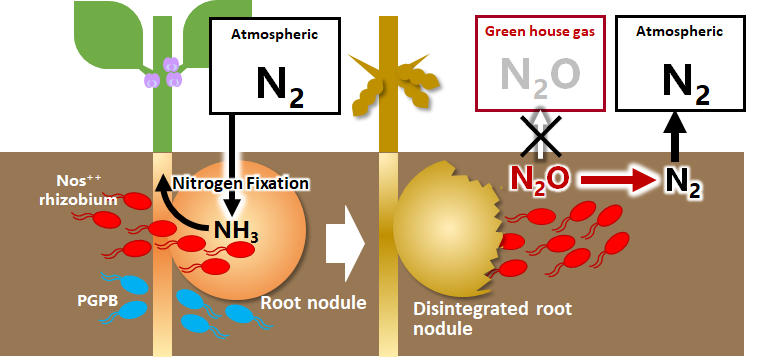The National Agriculture and Food Research Organization (NARO), in collaboration with Tohoku University has revealed that the root nodule bacterium Bradyrhizobium ottawaense, which has high ability to mitigate the emission of nitrous oxide(N2O), a greenhouse gas(GHG), with high expression of the gene encoding the enzyme that converts N2O to N2. Co-inoculation of B. ottawaense with the plant growth promoting microorganism Pseudomonas bacterium(helper microorganism) to soybean plants, has resulted in the improvement of nitrogen fixation ability of the B. ottawaense and growth of soybean plants. Hence, it is expected that combined use of B. ottawaense which has high N2O reduction capacity and helper microorganisms will lead to technological development that will increase the potential of both N2O emission reduction and soybean production in agricultural land.
Overview
N2O is known as a GHG with 265 times more global warming potential than carbon dioxide(CO2). Approximately 82% of anthropogenic N2O emissions are reported to originate from agricultural production. N2O emissions from excessive use of chemical fertilizers and crop residues has become a problem. (Source:National Institute for Environmental Studies Global Nitrous Oxide Budget 2020). Therefore, there is a high demand for the development of an agricultural technology that suppresses N2O generation.
In legumes such as soybeans, rhizobia infect symbiotically on the roots and form symbiotic organ called root nodules. Inside the nodules, rhizobia convert atmospheric nitrogen(N2) into ammonia(NH3) by nitrogen fixation and supply it to legumes as a nutrient. In 2020, a research team from Tohoku University isolated several strains of the root nodule bacterium B. ottawaense, which has the ability to convert N2O into N2, from sorghum roots. This time NARO, in collaboration with a research group from Tohoku University, studied the properties of B. ottawaense. In the SG09 strain, which possess high N2O conversion ability, the expression levels of the enzyme gene(nosZ gene) that converts N2O to N2 was found to be high. The SG09 strain also infects symbiotically with soybeans. Therefore, the amount of N2O emitted from the roots of soybeans in which the SG09 strain formed nodules was examined. It was found that the amount of N2O emitted was reduced to up to one-tenth compared to roots in which conventional rhizobia infected. Additionally, when the SG09 strain was inoculated into soybean plants together with the plant growth promoting Pseudomonas bacterium OFT2 strain(helper microorganism), the nitrogen fixation ability of the SG09 strain increased by approximately 2-fold, and soybean growth also increased.
Legumes can grow with less nitrogen fertilizer input than other crops because they can use NH3 as nutrients via nitrogen fixation by rhizobia. Simultaneous inoculation of the SG09 strain of B. ottawaense and the OFT2 strain of helper microorganisms enables "Further reduction in nitrogen fertilizer due to improved nitrogen fixation capacity". Also, the SG09 strain, which is released into the soil as aged nodules break down, converts N2O in the soil into N2. This enables the possibility of reduction of N2O emissions from agricultural land. Reduction of the nitrogen fertilizer usage and GHG emissions will contribute to the development of a sustainable soybean production system.
This research result was published in the online version of Scientific Reports on November 1, 2023 and October 10, 2023.

Soybean cultivation model combining SG09 rhizobia and OFT2 helper microorganisms
Related Information
Budget:
・NEDO Moonshot Research and Development Program「Realization of sustainable resource circulation to recover the global environment」(2020 -2024)
・Grant-in-Aid for Japan Society for the Promotion of Science(JSPS) Fellows [Grant Numbers: 20J12228, 22J01397]
Patent:WO2022149590
Publication
Bradyrhizobium ottawaense efficiently reduces nitrous oxide through high nosZ gene expression.
Sawa Wasai-Hara, Manabu Itakura, Arthur Fernandes Siqueira, Daisaku Takemoto, Masayuki Sugawara, Hisayuki Mitsui, Shusei Sato, Noritoshi Inagaki, Toshimasa Yamazaki, Haruko Imaizumi-Anraku, Yoshikazu Shimoda & Kiwamu Minamisawa. Scientific Reports (2023) 13:18862.
DOI: https://doi.org/10.1038/s41598-023-46019-w
Synergistic N2-fixation and salt stress mitigation in soybean through dual inoculation of ACC deaminase-producing Pseudomonas and Bradyrhizobium.
Khin Thuzar Win, Sawa Wasai-Hara, Fukuyo Tanaka, Aung Zaw Oo, Kiwamu Minamisawa, Yoshikazu Shimoda & Haruko Imaizumi-Anraku. Scientific Reports (2023) 13:17050
DOI: https://doi.org/10.1038/s41598-023-43891-4




